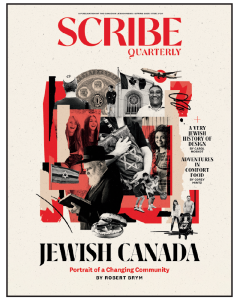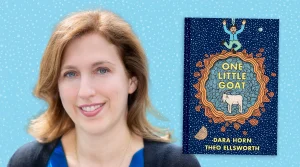It was 1978. I was sitting in Grade 12 biology – trying to get the nerve to dissect a frog – when I noticed a classmate was wearing a T-shirt that had just one word on it – “Picture.”
It was an odd thing to see, so I asked her about it. She excitedly explained that she and three other friends each had one word on a T-shirt so that when they were together, their shirts spelled out the movie title Rocky Horror Picture Show .
Well, I had no idea why she was so fascinated by this film. She tried to explain how great it was – but eventually, like most people who were into Rocky Horror in the 70s, I had to see it and experience it, just to understand.
So, a few months later, I went with three brave friends, to the infamous Roxy cinema on the Danforth where The Rocky Horror Picture Show was playing weekly, late on Saturday nights. There was always a double feature and the first movie was generally horrible. Somehow, we sat through it, waiting with anticipation – or is that antici—pation for the main feature to begin. Meanwhile the audience was filled with teenagers who were smoking pot and getting pumped for the show to start.
Briefly, The Rocky Horror Picture Show is a satirical musical horror film parody that revolves around the main character Dr. Frank-N-Furter, who describes himself as a “sweet transvestite from transsexual Transylvania,” and the events that occur when a young couple, Brad and Janet, arrive at his castle after their car breaks down.
We had never seen an event like this. Costumed people danced in front of the screen, while the rest of the audience used props such as newspapers, water guns, and toast – all to make fun of the unfolding action. It was enticing and liberating. Buying the album helped me to learn the words to every song. We dressed up on Halloween and did the Time Warp at every party – including falling down at the end.
Looking back, I realize that only a select group of people are part of the rabid first wave fans of this cult classic – most likely those between 50 and 60 years old. Like me, I assume that these people feel like teenagers when they hear the beginning strains of songs like Time Warp or Sweet Transvestite.
Before the movie there was the play. The Rocky Horror Show was originally staged in England, in part due to the efforts of Jewish producer, Michael White. Australian actor, Richard O’Brien, who played Riff Raff, wrote the original play and lyrics and went on to co-write the 1975 film with Jim Sharman.
O’Brien is said to have been influenced by his friend John Sinclair, a young actor and music producer who later in life become an Orthodox rabbi, who now resides in Israel.
READ: ISRAELI THEATRE COMPANY BRINGS THE DYBBUK TO TORONTO
Another Jewish connection came through Lou Adler, who saw something in the play and managed to get it produced for film on a low budget in England. After a slow start it developed its famous cult following and has been consistently playing second run for the past 43 years. Taking Jewish connections a step further, in the film, Tim Curry’s lab coat has a bold red triangle, from the Holocaust era, when gay prisoners were forced to wear these badges on their uniforms. In the 70s this symbol helped to bring awareness to the marginalized LGBTQ community.

When I first heard that the Stratford Festival was taking on the Rocky Horror Show, it was difficult to picture typical staid audiences, enjoying or even understanding this play. Explanations of the unique experience is offered in their marketing materials, to prepare the uninitiated.
I found the audience at the show I attended to be a strange mix of those who love these songs and theatrics and those who were Rocky Horror virgins trying to make sense of the experience. At one point during intermission, an elderly man next to me asked me why I liked this play. While I earnestly tried to explain it to him (emphasizing the references to old horror films over the sexual content) a man in front of me turned and said “ Can you please stop talking about things before they happen?”
Even after all the explanations about the show’s interactivity– newbies can’t seem to understand that this is fun of the show. To his credit, the first man said, “I like the music.”
I thoroughly enjoyed the play at Stratford, especially the interaction between the audience and the performers. The narrator played by Steve Ross was captivating, unlike the film version’s, whom I truly found boring. Ross’s tone, expressions and ability to interact with the audience, no matter what was thrown at him, were a joy to behold.
Picture sitting with your parents while filthy and nonsensical things are shouted out and responded to by respected thespians. I was giddy with excitement to see the talented Stratford cast perform – while being embarrassed and frustrated that the people around me were telling me off for shouting out my favourite lines.
The patrons were an eclectic bunch at this performance. Groups of friends stood in the lobby wearing feather boas and black hats. Next to them stood a middle-aged couple dressed perfectly as Brad and Janet from the wedding scene. Grab bags with acceptable props were sold in the gift shop. Halloween promises to bring the liveliest audiences this year.
I couldn’t help but miss certain things that were in the film but not in the play such as the wacky costumes of the iconic Transylvanians, which were replaced by slithering back-up singers in skimpy leather.
The other difference between seeing it then and now was how I felt hearing insults shouted at the characters. In the “#MeToo era – and well before it – I have become uncomfortable hearing Janet called “slut” repeatedly throughout the film. It is incessant, demeaning and takes away from the message that we all have the right to self-determination. But old habits die hard. This was the way it was done back then and some people coming to the play are reliving the experience in a new format.
I will always think of Tim Curry as Dr. Frank-N-Furter but Dan Chameroy’s take on the character provided a confident and striking sweet transvestite. Shout-outs also go to Robert Markus and Kimberly-Ann Truong who both did amazing work with their roles as Riff Raff and Colombia.
Kudos to the Stratford Festival for taking a risk and presenting a play that breaks with tradition in a delightful way and for introducing a whole new generation of fans to the amazing phenomenon that it is Rocky Horror (Picture) Show.
The Rocky Horror Show will be playing in Stratford, through November of 2018.
For tickets visit: www.stratfordfestival.ca







